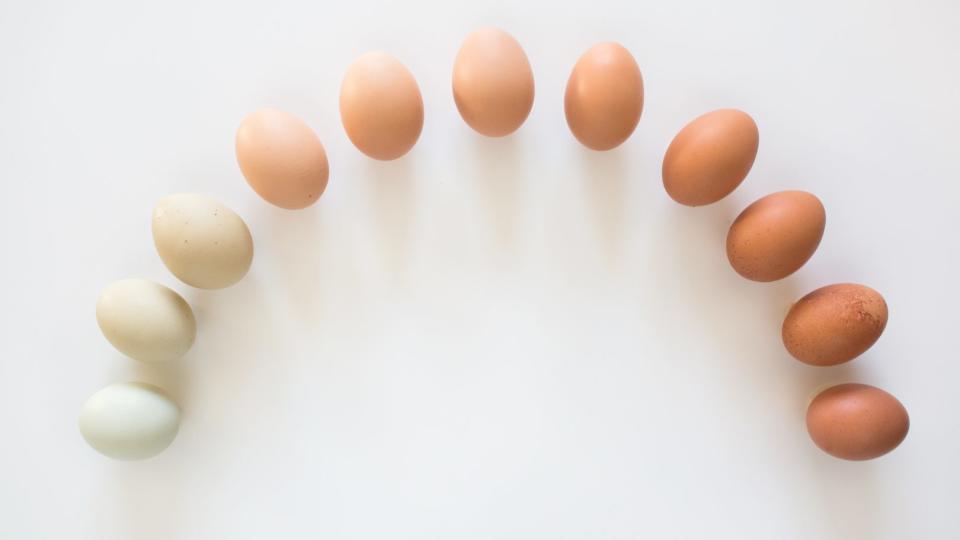The Complete Guide to Eggs: What’s the difference between cage-free, free-range, and pasture-raised eggs?

Joey Skladany is an In The Know cooking contributor. Follow him on Instagram and visit his website for more.
Scrambled, poached, over easy or boiled — no matter how you crack it, eggs have become a beloved staple in our everyday diets. But not all eggs are created equal. In fact, a simple trip to the grocery store can lead to some confusion over terms like cage-free, free-range and pasture-raised.
So, what makes one egg better than the other? Well, that’s entirely subjective and up to you as a shopper. Only you can decide what farming practices are most humane and how much you’re willing to spend on taste and quality.
At the very least, you can now consult this handy guide before making any major egg decisions going forward. Keep in mind that these are standards instituted by the USDA and that many companies try to cut corners to earn specific grade marks. It’s up to you as a consumer to research where your eggs come from so that you can get an honest picture of the hens’ actual living environments.
Cage-free eggs
This one is a bit self-explanatory, but cage-free applies to any egg laid by a chicken that’s not in a cage. Many factory farms have come under fire for cramming hens into tiny, unsanitary cages that deprive them of any sort of quality of life.
These inhumane practices have been condemned by veterinarians and animal rights groups worldwide, but it’s important to note that the USDA cage-free certification doesn’t enforce any specific space requirements for chickens, meaning that while hens may not be in a cage, they could be in equally terrible living conditions where they are crowded and unable to roam freely.
As an alternative, look for cage-free options that also bear a Certified Humane label (issued by the Humane Farm Animal Care organization). These chickens are required to have at least 1.5 square feet of space, as well as other animal welfare standards like air quality, access to light and perch availability.
Free-range eggs
The only difference between cage-free and free-range is that chickens must have access to the outdoors. Per the USDA, cartons marked as free-range “must be produced by hens housed in a building, room, or area that allows for unlimited access to fresh food and water and continuous access to the outdoors during their laying cycle. The outdoor area may be fenced and/or covered with netting-like material.”
Like cage-free, the USDA does not specify a chicken limit, so it’s entirely possible that hens won’t be able to make their way outside on a daily basis. The outdoor space could also be tiny and practically inhospitable since there are no strict guidelines set in place.
Again, the Certified Humane label will ensure that chickens are not only guaranteed two square feet of outdoor space, but also have access to a minimum of six hours outside to promote humane farming practices.
Pasture-raised eggs
These are the eggs you’ll find at most farmer’s markets — small-batch dozens sold from the farmers themselves who guarantee that their hens roam freely and eat a wonderful all-natural diet sans soy or corn.
Unsurprisingly, there are zero USDA regulations in place when it comes to pasture-raised eggs, but the Certified Humane label will ensure that chickens are actually *required* to roam freely outside for six hours and with 2.5 acres of land per 1,000 birds.
This type of farming environment obviously requires a lot more work and upkeep, so egg prices will be significantly more expensive. Most pasture-raised eggs with the Certified Humane seal will also execute eco-friendly farming practices, so it’s a purchase you can at least — from a moral standpoint — feel good about, especially because it supports small businesses.
Final thoughts
When it comes to eggs, taste is synonymous with quality. Nothing comes close to the buttery, rich, deep orange yolk of an egg from a happy hen and we implore you to conduct your own taste test to discover the difference. Chances are likely that you’ll savor the indulgence and never look back.
If you enjoyed this article, check out these five tips for elevating your avocado toast!
The post The Complete Guide to Eggs: What’s the difference between cage-free, free-range, and pasture-raised eggs? appeared first on In The Know.
More from In The Know:
Student's anatomy drawings featuring Black bodies stun social media
The 7 best gifts for the man who has everything

 Yahoo Finance
Yahoo Finance 